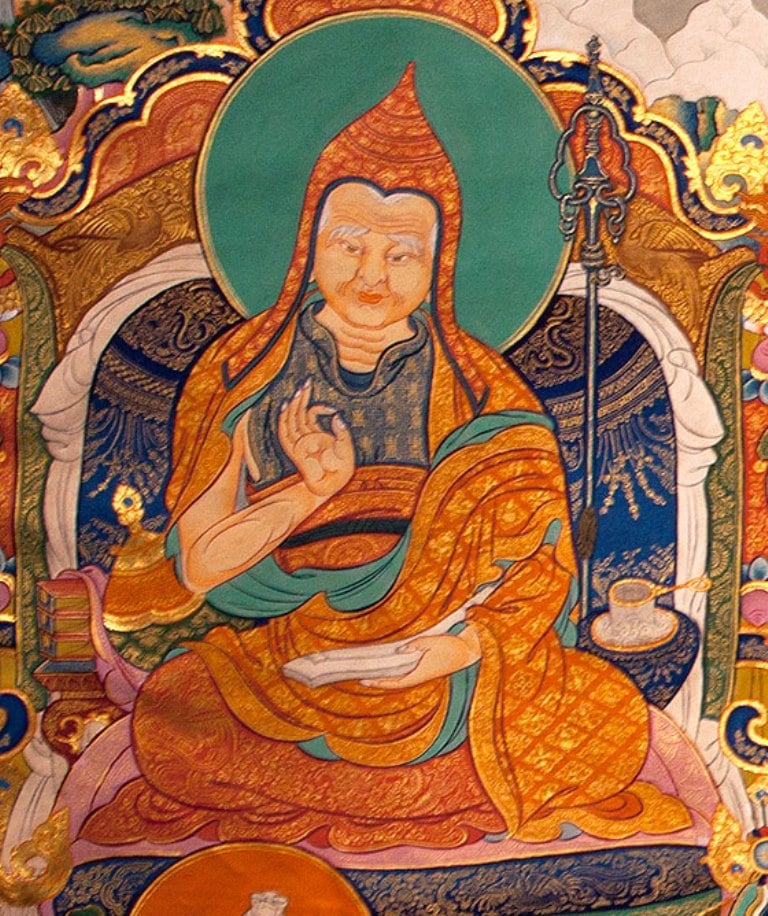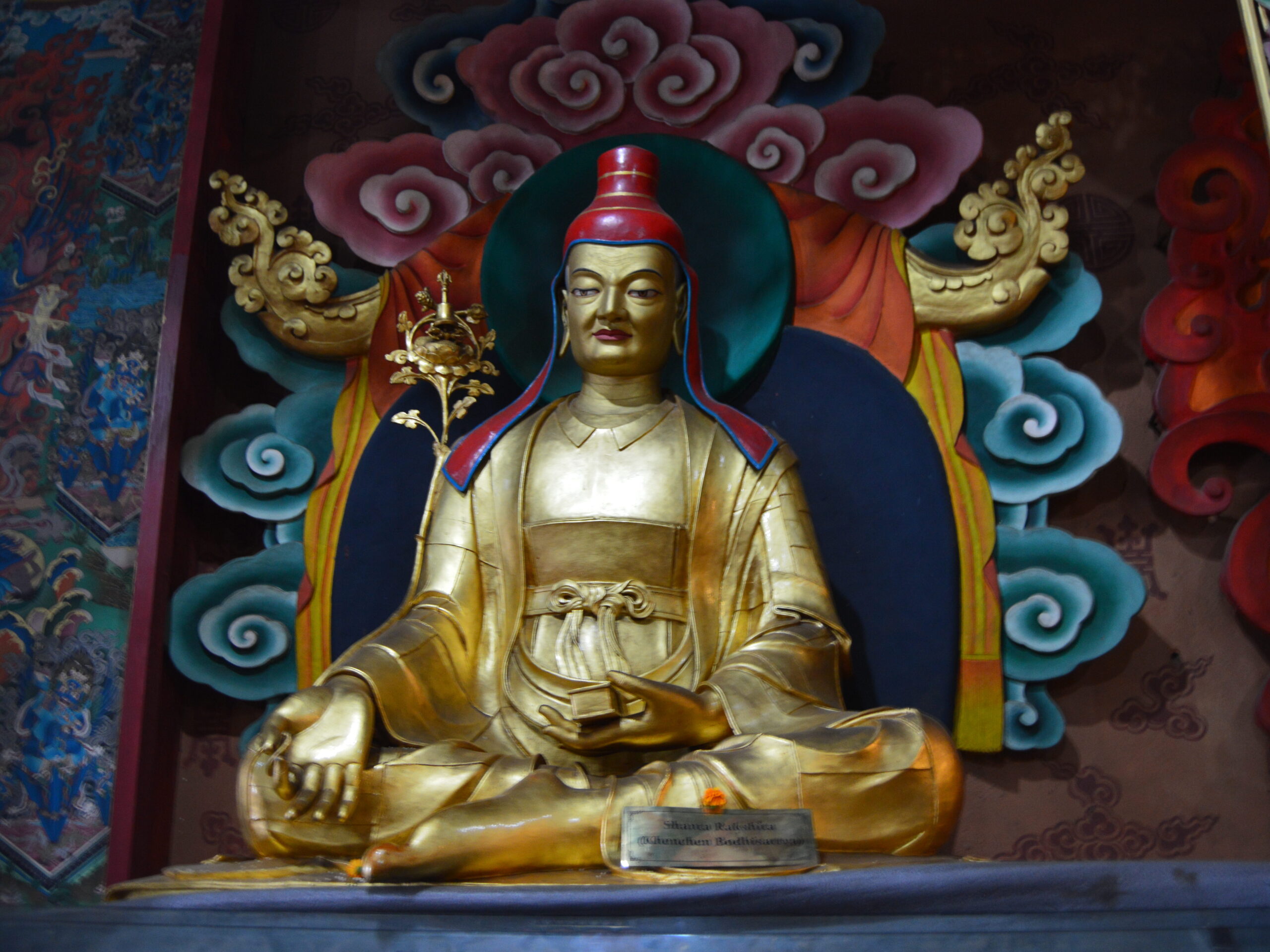Santaraksita, The Greatest Contributor to Tibetan Buddhism, also known as Santaraksita or Santaraksita, was a prominent Indian Buddhist philosopher and scholar. He is best known for his role in revitalizing Buddhism in Tibet and for his synthesis of Madhyamaka and Yogācāra philosophies. Santaraksita’s life and works are significant not only in the historical context of Indian and Tibetan Buddhism but also for their relevance to contemporary philosophical and religious discourse.


Biography of Santaraksita
Śāntarakṣita was born in the early 8th century CE in the Indian subcontinent, possibly in the region of Kerala. He entered monastic life at a young age and studied Buddhist philosophy under the guidance of renowned scholars of the time. Santaraksita’s early education likely included a thorough grounding in the various schools of Buddhist thought prevalent in India at that time, including the Madhyamaka, Yogācāra, and Sautrāntika schools.
Santaraksita’s intellectual prowess and spiritual dedication soon became evident, and he rose to prominence as a scholar and teacher. He is said to have engaged in philosophical debates with scholars of other traditions, demonstrating his mastery of Buddhist doctrine and his ability to defend it against detractors.
One of the defining moments in Śāntarakṣita’s life was his journey to Tibet at the invitation of the Tibetan king, Trisong Detsen, in the 8th century CE. The king sought Santaraksita’s help in establishing Buddhism in Tibet and in countering the influence of rival religious traditions. Santaraksita’s arrival in Tibet marked the beginning of a new era in Tibetan Buddhism, characterized by a flourishing of Buddhist scholarship and practice.
Santaraksita’s legacy in Tibet is primarily associated with the establishment of the first Buddhist monastery in Tibet, known as Samye Monastery. He played a key role in the design and construction of the monastery, which served as a center for Buddhist learning and practice. Santaraksita’s teachings also laid the foundation for the development of Tibetan Buddhist philosophy, particularly in the areas of Madhyamaka and Yogācāra.
Santaraksita’s influence continued long after his death, with his works and ideas shaping the course of Tibetan Buddhism. His synthesis of Madhyamaka and Yogācāra, known as Yogācāra-Svatantrika-Madhyamaka, became one of the dominant philosophical schools in Tibetan Buddhism, influencing the thought of scholars and practitioners for centuries to come.
Philosophical Contributions
Santaraksita’s philosophical contributions are multifaceted, encompassing a wide range of topics including metaphysics, epistemology, ethics, and meditation. His synthesis of Madhyamaka and Yogācāra is perhaps his most significant contribution, as it represents a unique approach to understanding the nature of reality and the mind.
Synthesis of Madhyamaka and Yogācāra
Santaraksita’s synthesis sought to reconcile the seemingly contradictory teachings of Madhyamaka, which emphasizes the emptiness or lack of inherent existence of all phenomena, and Yogācāra, which posits the existence of a foundational consciousness (ālayavijñāna) that underlies all mental activity. According to Śāntarakṣita, the key to understanding this apparent contradiction lies in recognizing the different levels of truth or reality (satya) that exist. He distinguishes between conventional truth (saṃvṛtisatya) and ultimate truth (paramārthasatya), arguing that while conventional truth is characterized by the ordinary dualistic perception of subject and object, ultimate truth reveals the ultimate nature of reality as empty of inherent existence.
Wisdom and Compassion
Śāntarakṣita emphasizes the importance of cultivating wisdom (prajñā) and compassion (karuṇā) as complementary aspects of the path to enlightenment. For him, true wisdom arises from a deep understanding of the ultimate nature of reality, while compassion arises from the realization of the interconnectedness of all beings.
Relevance in Contemporary Contexts
Śāntarakṣita’s philosophy of harmony and wisdom has enduring relevance in contemporary contexts, particularly in the fields of philosophy, psychology, and ethics. His emphasis on the interplay between wisdom and compassion resonates with modern theories of moral development and ethical behavior, highlighting the importance of cultivating both cognitive and affective dimensions of moral reasoning.
Furthermore, Śāntarakṣita’s insights into the nature of reality and the mind have implications for contemporary debates in philosophy of mind and cognitive science. His analysis of consciousness and mental phenomena offers a unique perspective on the relationship between mind and world, challenging conventional dualistic frameworks in favor of a more nuanced understanding of the nature of experience.


Contribution to Tibetan Buddhism
Śāntarakṣita made several significant contributions to Tibetan Buddhism, which had a lasting impact on its development. Some of his key contributions include:
1. Establishment of Samye Monastery: Śāntarakṣita played a crucial role in the establishment of Samye Monastery in Tibet, which was the first Buddhist monastery in the region. This monastery became a center for Buddhist learning and practice, laying the foundation for the spread of Buddhism in Tibet.
2. Revitalization of Buddhism in Tibet: Śāntarakṣita’s teachings and guidance helped revitalize Buddhism in Tibet during a time when it was facing challenges from other religious traditions. His presence in Tibet marked the beginning of a new era of Buddhist scholarship and practice in the region.
3. Synthesis of Madhyamaka and Yogācāra: Śāntarakṣita’s synthesis of Madhyamaka and Yogācāra philosophies had a profound influence on Tibetan Buddhist thought. This synthesis, known as Yogācāra-Svatantrika-Madhyamaka, became one of the dominant philosophical schools in Tibetan Buddhism, shaping the thinking of scholars and practitioners for centuries.
4. Promotion of Wisdom and Compassion: Śāntarakṣita emphasized the cultivation of wisdom (prajñā) and compassion (karuṇā) as essential aspects of the Buddhist path. His teachings on wisdom and compassion continue to be central to Tibetan Buddhist practice, highlighting the importance of both intellectual understanding and compassionate action.
5. Legacy of Scholarship: Śāntarakṣita’s legacy as a scholar and teacher continued long after his death, with his works and ideas influencing generations of Tibetan Buddhist scholars. His writings are still studied and revered in Tibetan Buddhist monastic institutions, ensuring that his contributions remain a vital part of Tibetan Buddhist intellectual heritage.
Conclusion
Śāntarakṣita’s life and works exemplify the richness and depth of Indian Buddhist philosophy. His synthesis of Madhyamaka and Yogācāra stands as a testament to his intellectual acumen and spiritual insight, offering a profound and compelling vision of the nature of reality and the mind. Through his teachings, Śāntarakṣita continues to inspire scholars and practitioners alike, reminding us of the timeless wisdom and enduring relevance of Buddhist philosophy.
Learn More About Buddhism
FAQ
Did Santaraksita establish Tibetan Buddhism?
No, Śāntarakṣita did not establish Tibetan Buddhism. He was a key figure in the revitalization of Buddhism in Tibet in the 8th century CE, but the tradition was already established in Tibet before his arrival. Śāntarakṣita’s role was in helping to consolidate and expand the presence of Buddhism in Tibet through his teachings and the establishment of Samye Monastery.
Who built the Samey Monastery of Tibet?
Samye Monastery in Tibet was built under the patronage of King Trisong Detsen in the 8th century. It was constructed with the help of Indian Buddhist masters, including Śāntarakṣita and Padmasambhava, and is considered the first Buddhist monastery established in Tibet.
who are the first Tibetan monks?
The first Tibetan monk is traditionally believed to be seven Tibetan monks, who were ordained by the Indian Buddhist master Śāntarakṣita. Trisong Detsen, as the Tibetan king, played a crucial role in the early spread and establishment of Buddhism in Tibet.
Reference
- Hayes, R. P. (1988). Dignāga on the Interpretation of Signs. Dordrecht: Kluwer Academic Publishers.
- Hopkins, J. (2006). Mountain Doctrine: Tibet’s Fundamental Treatise on Other-Emptiness and the Buddha-Matrix. Ithaca, NY: Snow Lion Publications.
- Stearns, C. (1999). The Buddha from Dölpo: A Study of the Life and Thought of the Tibetan Master Dölpopa Sherab Gyaltsen. Albany, NY: State University of New York Press.
- Wayman, A. (2007). Yogācāra Buddhism: A Bibliography. Honolulu, HI: University of Hawai’i Press.
FOLLOW US ON




cucumber naw and ladonna and good and addon spark, all people good http://vo.74z5mlou3.top/xlwzg
WONDERFUL Post.thanks for share..more wait .. …